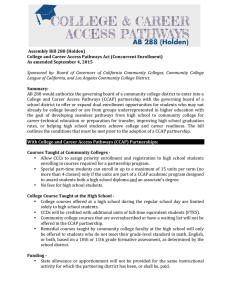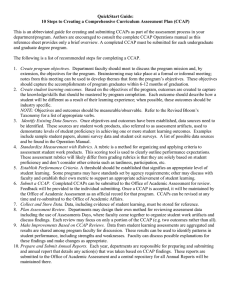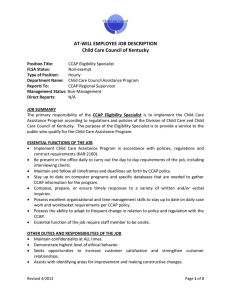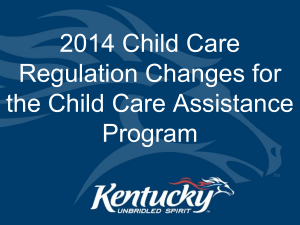Introduction
advertisement
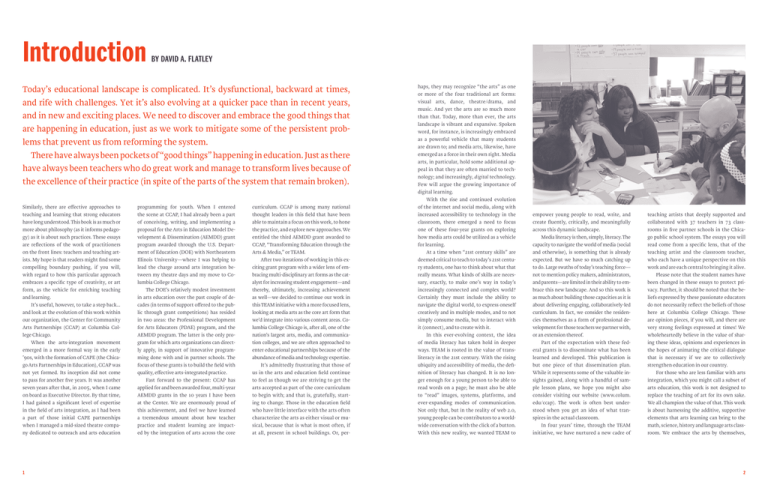
Introduction BY DAVID A. FLATLEY Today’s educational landscape is complicated. It’s dysfunctional, backward at times, and rife with challenges. Yet it’s also evolving at a quicker pace than in recent years, and in new and exciting places. We need to discover and embrace the good things that are happening in education, just as we work to mitigate some of the persistent problems that prevent us from reforming the system. There have always been pockets of “good things” happening in education. Just as there have always been teachers who do great work and manage to transform lives because of the excellence of their practice (in spite of the parts of the system that remain broken). Similarly, there are effective approaches to teaching and learning that strong educators have long understood. This book is as much or more about philosophy (as it informs pedagogy) as it is about such practices. These essays are reflections of the work of practitioners on the front lines: teachers and teaching artists. My hope is that readers might find some compelling boundary pushing, if you will, with regard to how this particular approach embraces a specific type of creativity, or art form, as the vehicle for enriching teaching and learning. It’s useful, however, to take a step back… and look at the evolution of this work within our organization, the Center for Community Arts Partnerships (CCAP) at Columbia College Chicago. When the arts-integration movement emerged in a more formal way in the early ’90s, with the formation of CAPE (the Chicago Arts Partnerships in Education), CCAP was not yet formed. Its inception did not come to pass for another five years. It was another seven years after that, in 2005, when I came on board as Executive Director. By that time, I had gained a significant level of expertise in the field of arts integration, as I had been a part of those initial CAPE partnerships when I managed a mid-sized theatre company dedicated to outreach and arts education 1 programming for youth. When I entered the scene at CCAP, I had already been a part of conceiving, writing, and implementing a proposal for the Arts in Education Model Development & Dissemination (AEMDD) grant program awarded through the U.S. Department of Education (DOE) with Northeastern Illinois University—where I was helping to lead the charge around arts integration between my theatre days and my move to Columbia College Chicago. The DOE’s relatively modest investment in arts education over the past couple of decades (in terms of support offered to the public through grant competitions) has resided in two areas: the Professional Development for Arts Educators (PDAE) program, and the AEMDD program. The latter is the only program for which arts organizations can directly apply, in support of innovative programming done with and in partner schools. The focus of these grants is to build the field with quality, effective arts-integrated practice. Fast forward to the present: CCAP has applied for and been awarded four, multi-year AEMDD grants in the 10 years I have been at the Center. We are enormously proud of this achievement, and feel we have learned a tremendous amount about how teacher practice and student learning are impacted by the integration of arts across the core curriculum. CCAP is among many national thought leaders in this field that have been able to maintain a focus on this work, to hone the practice, and explore new approaches. We entitled the third AEMDD grant awarded to CCAP, “Transforming Education through the Arts & Media,” or TEAM. After two iterations of working in this exciting grant program with a wider lens of embracing multi-disciplinary art forms as the catalyst for increasing student engagement—and thereby, ultimately, increasing achievement as well—we decided to continue our work in this TEAM initiative with a more focused lens, looking at media arts as the core art form that we’d integrate into various content areas. Columbia College Chicago is, after all, one of the nation’s largest arts, media, and communication colleges, and we are often approached to enter educational partnerships because of the abundance of media and technology expertise. It’s admittedly frustrating that those of us in the arts and education field continue to feel as though we are striving to get the arts accepted as part of the core curriculum to begin with; and that is, gratefully, starting to change. Those in the education field who have little interface with the arts often characterize the arts as either visual or musical, because that is what is most often, if at all, present in school buildings. Or, per- haps, they may recognize “the arts” as one or more of the four traditional art forms: visual arts, dance, theatre/drama, and music. And yet the arts are so much more than that. Today, more than ever, the arts landscape is vibrant and expansive. Spoken word, for instance, is increasingly embraced as a powerful vehicle that many students are drawn to; and media arts, likewise, have emerged as a force in their own right. Media arts, in particular, hold some additional appeal in that they are often married to technology; and increasingly, digital technology. Few will argue the growing importance of digital learning. With the rise and continued evolution of the internet and social media, along with increased accessibility to technology in the classroom, there emerged a need to focus one of these four-year grants on exploring how media arts could be utilized as a vehicle for learning. At a time when “21st century skills” are deemed critical to teach to today’s 21st century students, one has to think about what that really means. What kinds of skills are necessary, exactly, to make one’s way in today’s increasingly connected and complex world? Certainly they must include the ability to navigate the digital world, to express oneself creatively and in multiple modes, and to not simply consume media, but to interact with it (connect), and to create with it. In this ever-evolving context, the idea of media literacy has taken hold in deeper ways. TEAM is rooted in the value of transliteracy in the 21st century. With the rising ubiquity and accessibility of media, the definition of literacy has changed. It is no longer enough for a young person to be able to read words on a page; he must also be able to “read” images, systems, platforms, and ever-expanding modes of communication. Not only that, but in the reality of web 2.0, young people can be contributors to a worldwide conversation with the click of a button. With this new reality, we wanted TEAM to empower young people to read, write, and create fluently, critically, and meaningfully across this dynamic landscape. Media literacy is then, simply, literacy. The capacity to navigate the world of media (social and otherwise), is something that is already expected. But we have so much catching up to do. Large swaths of today’s teaching force— not to mention policy makers, administrators, and parents—are limited in their ability to embrace this new landscape. And so this work is as much about building those capacities as it is about delivering engaging, collaboratively-led curriculum. In fact, we consider the residencies themselves as a form of professional development for those teachers we partner with, or an extension thereof. Part of the expectation with these federal grants is to disseminate what has been learned and developed. This publication is but one piece of that dissemination plan. While it represents some of the valuable insights gained, along with a handful of sample lesson plans, we hope you might also consider visiting our website (www.colum. edu/ccap). The work is often best understood when you get an idea of what transpires in the actual classroom. In four years’ time, through the TEAM initiative, we have nurtured a new cadre of teaching artists that deeply supported and collaborated with 37 teachers in 73 classrooms in five partner schools in the Chicago public school system. The essays you will read come from a specific lens, that of the teaching artist and the classroom teacher, who each have a unique perspective on this work and are each central to bringing it alive. Please note that the student names have been changed in these essays to protect privacy. Further, it should be noted that the beliefs expressed by these passionate educators do not necessarily reflect the beliefs of those here at Columbia College Chicago. These are opinion pieces, if you will, and there are very strong feelings expressed at times! We wholeheartedly believe in the value of sharing these ideas, opinions and experiences in the hopes of animating the critical dialogue that is necessary if we are to collectively strengthen education in our country. For those who are less familiar with arts integration, which you might call a subset of arts education, this work is not designed to replace the teaching of art for its own sake. We all champion the value of that. This work is about harnessing the additive, supportive elements that arts learning can bring to the math, science, history and language arts classroom. We embrace the arts by themselves, 2 and we also embrace the idea that they can be used as a catalyst for learning other subject areas; that they support the development of executive functioning and other higher-order thinking skills…and that they effectively address social and emotional learning needs as well. These are important frames of reference to keep in mind. Finally, I believe it useful to share with the reader that TEAM is but one program within CCAP. While this publication is not about CCAP at large, to know that we are a part of a college that was established to support the rich linkages between the college and the community helps paint the fuller picture. Our mission is to expand learning in multiple directions, and to leverage the expertise of the college to support the learning laboratory we co-create with our partners in the community. We have modeled that well with the TEAM initiative. Project AIM, our broader arts-integration program within CCAP, has been a national leader in helping to build the field. It is Project AIM that has led the charge with the other AEMDD awards given to us by the DOE. But CCAP work extends beyond arts integration, and beyond the classroom. Our Community Schools initiative is also highly regarded, and focuses on wraparound services and a coordination of resources that support the whole child. In 2010, CCAP received one of 15 National Arts and Humanities Youth Program awards in the East Room of the White House from Michelle Obama in recognition of our out-of-school time arts programming for students. Our center also facilitates connections between college departments and their faculty, and the community-at-large. We work closely with a network of approximately 40 partners (mainly community-based arts organizations, or CBOs) to develop experiential learning opportunities, both for our college students and the youth that are served by those CBOs. Columbia College Chicago’s president, Dr. Kwang-Wu Kim, strongly sup- 3 ports the idea that the college be an animating force in our community; and when that can be coupled with engaged learning that supports the larger academic enterprise we have built in support of our students at this institution…then we have a formula that is a win-win all the way around. This larger frame, providing an understanding of what all CCAP does, is meant to contextualize what makes us well suited to take on this work. If we are charged with both serving our community and building rich learning environments for all the stakeholders involved, what better way than to build reciprocal partnerships that support the creation, and “pushing out,” of best practice models? To that end, these AEMDD grants have been a strong match for CCAP. As we consider ourselves a professional learning community, we also strive to build iterative learning into our work and our programming as we continue to grow. One project or set of learning experiences can evolve into, and inform, the next thing we explore. One of our most recently-developed programs is also funded through the DOE (Investing in Innovation) and is called Convergence Academies. There will be much to share from what we are learning there. What’s important to share here is that that initiative was directly born out of TEAM. Convergence embraces a still broader lens around how embedded digital learning can transform the culture and effectiveness of an entire school. It’s a bold project, but one with enormous promise. Project AIM seeded the more specific work of what would become TEAM; and likewise, TEAM seeded the vision for Convergence. Biography David A. Flatley is Executive Director of the Center for Community Arts Partnerships (CCAP) at Columbia College Chicago, which expands learning by connecting the college to public schools and communities. He has over two decades of experience in developing and implementing educational initiatives designed to improve teacher practice and student achievement, and effectively utilizing teaching artists in schools and community settings. He has an M.A. in Arts Administration from the University of Wisconsin-Madison, and a B.S. in Business Administration from the University of Illinois at UrbanaChampaign. He is a jazz pianist and writer. We invite you to learn more. 4
